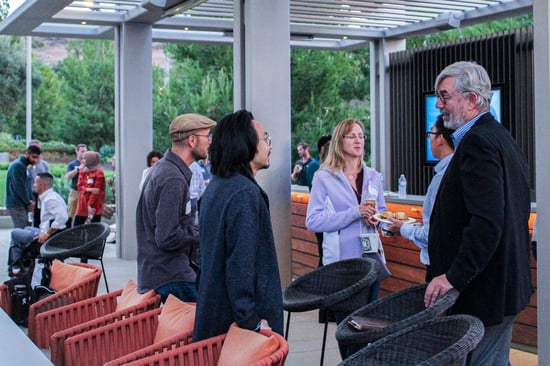According to LinkedIn's mission statement found on their site, “The mission of LinkedIn is simple: connect the world’s professionals to make them more productive and successful.” LinkedIn was introduced with a vision to “Create economic opportunity for every member of the global workforce.” Being one of the world's largest professional networks on the internet, professionals can use LinkedIn to find a job or internship that fits their background. It also keeps individuals connected and strengthens professional relationships. LinkedIn offers skill tests that you can learn and then earn a certificate in to elevate your abilities.
With the option to showcase your unique professional story, experiences, skills, and educational background, LinkedIn can better match you with opportunities. Moreover, LinkedIn can be used to organize offline events, join groups, write articles, and post photos and videos that highlight your professional journeys.
Keeping all of this information about LinkedIn in mind, having a profile while in school is an opportunity to track your educational achievements. Whether scoring an internship, succeeding in research, or meeting major milestones in your field, you can begin marketing yourself. By sharing your educational journey, you now have a track record of your potential, abilities, and accomplishments. These documented moments open doors to more opportunities while increasing your connection with those across various fields.
To begin a LinkedIn profile, first sign-up with an email. After signing up, begin setting up your profile by completing it with all the core content. You can enter and add categories as you see fit for your experience.
Here is a list of everything a profile should include:
Headshot
The best headshot is simple. For the backdrop, it is best to go with a solid color. In terms of color, consider using darker colors like navy blue, grey, or black; white is also a great option as well. Directing focus on the outfit, dress in formal business attire, and have a facial expression that conveys who you are. Since your headshot should focus on you, it should take up 60% of the frame in high resolution. Equally important, have someone else take your headshot, no selfies. Consider having your headshot taken in soft light, and use wise filters, black and white are okay. Below is an example, of a perfect headshot, paired with the right colors. If you are feeling extra creative, also include a background photo. The background photo can be anything you resonate with. Use the background as a chance to add personality to the LinkedIn page without being too distracting.

Header
The header is the place under your name and the first item that comes up when your profile is searched. Think of your header as a one-liner resume that gives your audience a quick overview of what you do. Having a compelling and enticing LinkedIn headline will give you an edge over other job-seekers because it is a single statement that can convince your audience to click on your profile and learn more about you. Especially because next to the header is the contact information, your goal is to have an enticing header, so employers click to contact you.
About
I was once told, that “the LinkedIn about section is like your elevator pitch.” This phrase means that the about section is a short open-ended summary that advertises the individual's professional life. Here, you share passions, skills, what you love, and goals, which provide an overview for defining who you are. Your about section tells your reader who you are and why you do what you do. You are sharing what makes you unique and a standout in your prospective positions.
🔬Read: How to Write a Winning Elevator Pitch
Experience
It is best to discuss relative experiences where you held a position that attributed to your career. Talk about your position, the company, and your accomplishments in a meaningful way. You can use your experience under your resume to get started on what positions to include, however, you should not copy and paste from your resume piece for piece. If you are a job seeker you do not want to play all of your cards up front or leave out key points. Another important note regarding experience is that you should only include companies that have a logo. Having a logo is paired with credibility that you held your position and associate with a company.
🔬Learn: How to Write a Resume
Licenses / Certifications
Those looking at your profile also have access to your licenses and certifications. If you do not have any, LinkedIn provides certifications where you can test your skills. Licenses and certifications are important because they provide credibility that backs up your knowledge, skills, and abilities. While your experience can corroborate your expertise and aptitude to perform, these serve as credentials validating your capacity. Since licenses/certifications are also usually paired with an exam, test, or training. This will show your innate ability to properly execute what you know.
Skills
The skills section on LinkedIn differs from your skills earned through training because sometimes they cannot be taught. For this reason, if your skills are something particular, you can be endorsed. Having this section set up on LinkedIn can be helpful since you can track your gain of skill and others you meet and work with can endorse these practical skills. Your specific skill can be anything from knowing more than one language, understanding software, or having a soft skill. No matter what the endorsed skill is it offers your network/industry a glimpse of what you offer and who has seen you bring that trait to the table.
Courses
As a student, there are probably plenty of courses you have taken. These courses should be included on your LinkedIn because it shows your network the knowledge you have acquired. In certain courses, it's possible that you learned a very specific topic, or became an expert in a specific subfield. These are courses you cannot have on your resume, but as a student, these courses can highlight what you know for future employers.
Projects
Being a college student means you are most likely completing team projects or independent projects. Either way, these projects can corroborate what you learned in a course and show your energy toward leading with your ideas. As a student, there is so much more opportunity to grow, while taking part in these projects. With LinkedIn, its accomplishments like a team project or an independent research project should be captured. In some applications or interviews, you might be asked to tell a story about independent tasks you took on or ways you have led a team.
Honors / Awards
Academic honors/awards are a great way to stand out. When you are in a school, these awards can especially become valuable when they are well-known achievements. Whether big or small, being recognized by larger universities is no easy task. If you receive an achievement, chances are you stand out. More likely than not, these awards mean something valuable, so highlight them for companies, recruiters, and potential employers to see. These professional awards are something to be proud of and highlight as milestone achievements.
Join Groups
Being part of groups on LinkedIn is a huge plus. You never want to be part of too many, but you want to be in at least one. Associating with a group means you are part of a select network. This network is your community where you need to be accepted after requesting to join or you were sent an invitation. If you are part of these selective groups, chances are you share a similar experience. These groups can be an advantage because they engage you with others by using a common point of interest. Moreover, it opens up the opportunity to chat about your shared group. There are so many different types, such as cohorts, alumni groups, or associations. One undergraduate student shared how being part of a specific cohort scored them an internship because the individual interviewing them was part of the same cohort 10 years prior. As it turned out, the cohort was still run by the same individual who made a lasting impact on both of them. The interviewer and interviewee bonded over this fact. All this information is to say “never underestimate the power of your network.”

Organizations
There are two different ways to engage with your audience, joining groups is the first way, and organizations are the second way. Organizations differ from groups because organizations are usually larger recognized clubs or associations you belong to. With organizations, you can simply state you belong to the organization and describe what the organization does. This portion differs from the group because the group has a LinkedIn page you are part of. Your organization may not always have an associated group page, but it can still be official and just as important. The organization may also be a large group and also have a group you can join. Having this section is available to emphasize your role in the organization or what the organization does. Ultimately, being able to describe your role is important because it could show your leadership, engagement with communities, and outreach.
After creating your LinkedIn profile, begin connecting with those in your school, and during your academic years. The wonderful experience about college is you will constantly be building your network. Attending events, such as industry night, volunteering with the community, or working in clubs, there are student panels, alumni associations, professors, and individuals who you might want to look to as a mentor or resource. These connections are all in your network and you should exchange LinkedIn profiles with them. You never know when you might need their help or they need yours.
For instance, a current engineer at Fuji Films shares how they met a recruiter as a sophomore while looking for internships. This student never was offered the internship position, but they exchanged LinkedIn contacts with the recruiter. Flash forward 4 years later, this student contacted this same connection on LinkedIn regarding open positions. Now graduated and fully qualified, the recruiter was able to assist in their interview with the lead manager, which led to their current position. Their advice to you is “It’s always better to exchange LinkedIn URLs.”
Even so, remember that, unlike most social networking sites, it is not meant to connect with just anybody. Connect with individuals who you know. Just as powerful as connecting to the right people can be, connecting with the wrong people is also a possibility. LinkedIn etiquette experts have shared that the proper way to use LinkedIn is to only accept invitations from those you know.

🔬 Learn About: 11 Reasons Why Networking is Essential
With LinkedIn and connections, these resources together can be used to shop for internships and jobs. In two ways, 1) Businesses will post open positions on LinkedIn and you can apply directly with your profile. If you ever go through LinkedIn individuals post for their company, corporations have “apply” buttons, and LinkedIn can send you alerts based on the type of position you are looking for. 2) Businesses can reach out to you. Whether it be a recruiter, hiring manager, or team of individuals, sometimes they search for keywords that may be on your page. After doing a background check, your profile-reported skills, knowledge, and expertise might correlate with what they need to fill the current position.
So, why is LinkedIn the most valuable social platform to have as a student? Well, if you need one more great reason, talent is valuable. Someone is looking for a candidate like you or you are searching for a candidate with that one very specific niche. The only way to increase the odds of finding that talent is to broaden your search. LinkedIn offers this screening for you, by connecting you with the world and helping the employee and employer find a match.
Download The Ultimate Guide to Wet Lab Incubators in Southern California, a handbook to assist life science start-ups through the entire decision-making process to find wet lab space.
Download Now